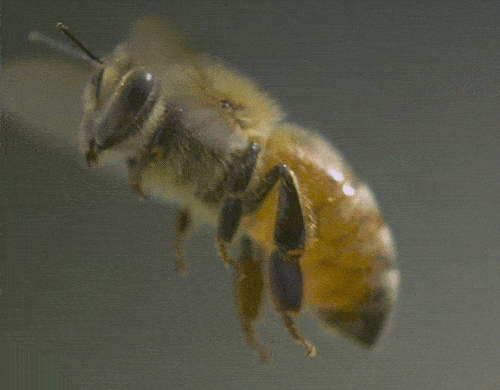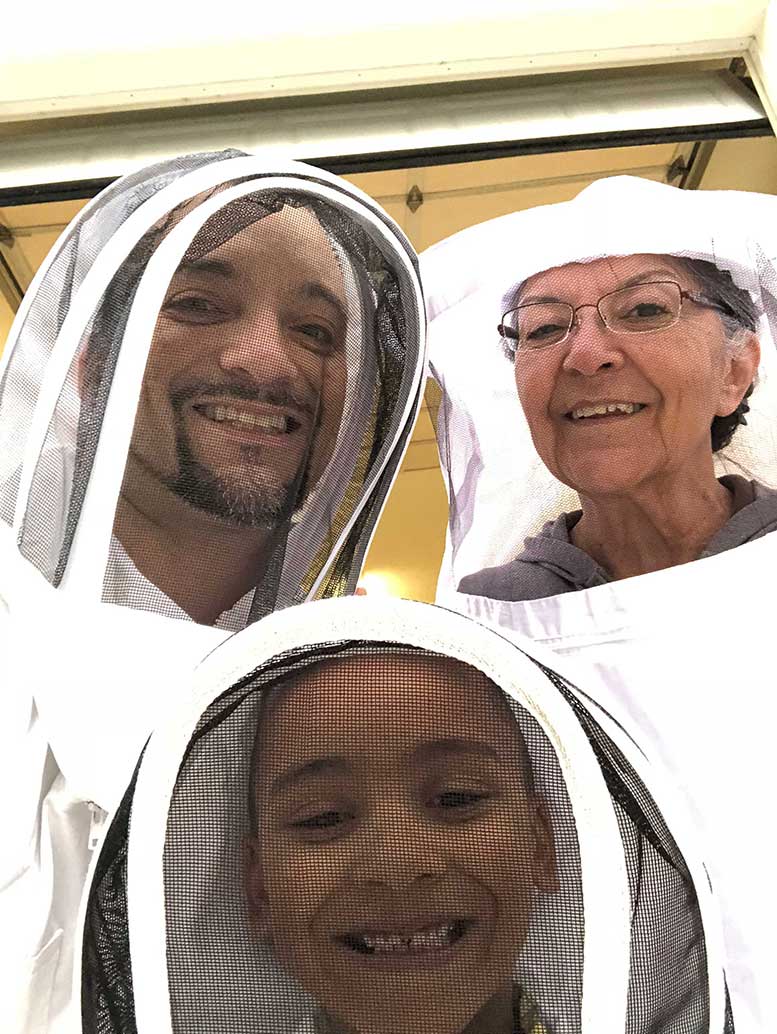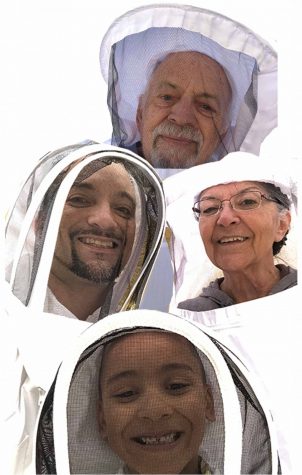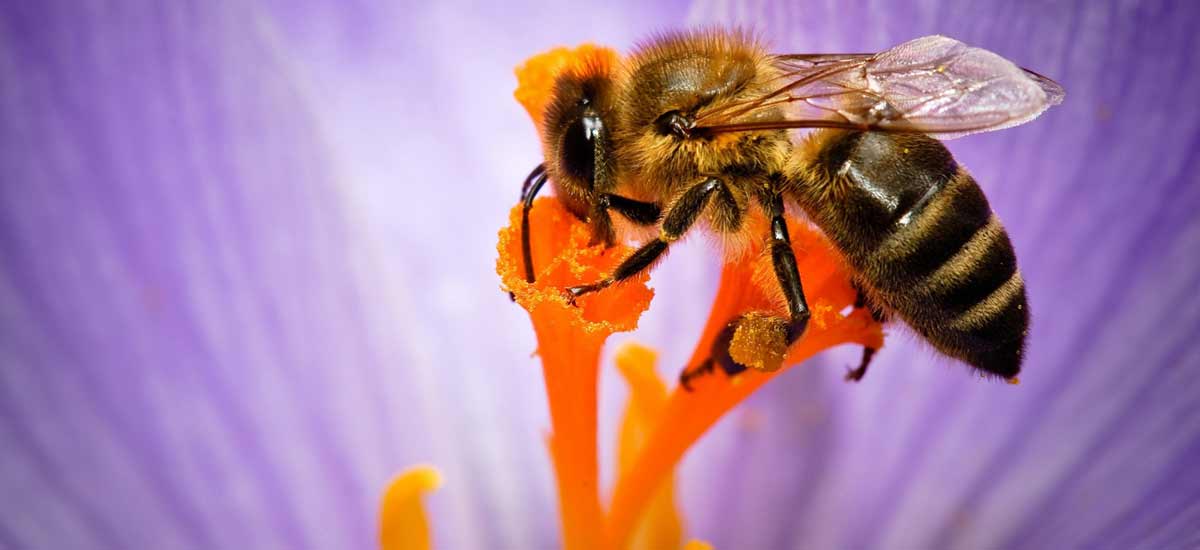- Your cart is empty
- Continue Shopping
About Honey Bees
 What are honey bees?
What are honey bees?
Honey bees are, according to dictionary.com, are any bee that collects and stores honey. They are found on every continent, except for Antarctica. Wild honey bees generally live in hollowed out trees, or other naturally protected areas. They build honey comb in these nesting sites, where they store honey, brood (larva) and pollen. Domesticated honey bees live in (usually) wooden, man-made hives. Honey bees are divided among three castes; the drone, the worker, and the queen. Each type of bee has a specific role in the colony. The drones are at the bottom of the caste. They are in charge of mating with the queen. In the winter, the worker bees kick the drones out of the hive, because they don’t work only eat honey. The queen selectively lays drones, but only a few dozen live in each hive. Drones are distinguishable- they have large ‘bug eyes’ and a wide but stunted abdomen. The workers make up the majority of the hive. Workers are female, and are the majority of the bees that the queen lays. Workers take care of the brood, protect the hive, build honeycomb, and forage for pollen and nectar. In the winter, the workers cluster around the queen to keep her warm. In a strong hive, there may be as many as eighty thousand workers. The queen bee is the most important bee in the hive. The queen is responsible for laying 1,500-2,000 eggs per day. In the winter, the worker bees cluster around her and keep her warm. The queen only leaves the hive once, to go on her mating flight after she hatches. To the right is an image of a queen that is being tended to by workers. The queen is longer and thinner than workers and drones.
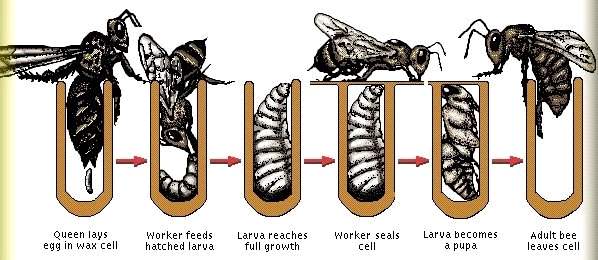 How do they grow?
How do they grow?
Every day, a queen lays a couple thousand eggs. All honey bees go through an egg, larva and pupae stage. Each caste stays in the different stages for slightly different amounts of time. After eight days, worker and queen bees are ‘capped’. This means that the bees build a thin layer of beeswax over the cell that the larva is in. This capping occurs on day ten for drones. The bees remain in this capping until they are ready to emerge. This is after about 16 days for queens, 21 days for workers, and 24 days for drones. Once the bee is ready to hatch, it chews the capping and exits the cell. Honey bees are considered a super-organism. Not only does the queen lay thousands of bees, but the hive splits itself in half each spring to ensure the species’ survival. This is through a process called swarming. Swarming usually occurs in the spring, when the existing queen lays several new queen bees, in ‘swarm cells’. Swarm cells (pictured bottom left) are long, peanut like cells, that the colony builds specially for a queen. Once the newly laid queens are about six days old, the original queen leaves the hive with a little over half of the workers. They relocate, and land on a branch or in a tree, where they prepare to build a new hive. In the original hive, one of the many queens hatch. She makes her way around to all of the other swarm cells, and stings the cells, killing her sisters and proclaiming herself The Queen. She will later leave for her mating flight, and soon after, she will start laying. If the colony survives the winter, this queen will likely leave the hive next spring, when the colony splits again. Domesticated bees- Beekeepers will play a part in making the decision of whether the colony swarms, or not. Swarming can be prevented by providing extra room for the queen to lay and for stored honey. Swarms can be encouraged by providing artificial queen cups, which are plastic cells that the queen will lay more queens in.
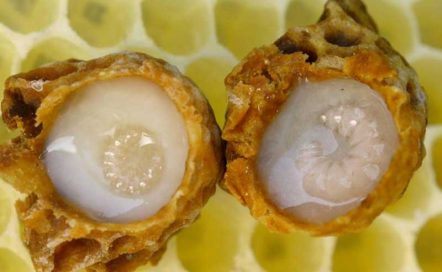 How do bees make and use honey, wax, propolis and royal jelly?
How do bees make and use honey, wax, propolis and royal jelly?
Why do bees make honey? A fully grown colony of bees can eat around 100 pounds of bees in the winter. They rely on this honey to survive year round. This is why forager bees spend spring and summer gathering nectar from many types of plants to make this honey. To make one pound of honey, bees must visit two million flowers. The forager bee uses its long tongue, called a proboscis, to drink nectar out of the flower. The bee returns to the hive after visiting many flowers, and deposits the nectar and pollen into separate cells. Other bees regurgitate the nectar between each other, adding enzymes from the bee’s stomachs. Finally, the nectar is fanned by the wings of the bees. The nectar has now turned to honey! The honey is capped with a thin, whitish layer of beeswax, to be stored and kept for the winter. While the worker is drinking nectar, she rubs up on pollen, which collects in her ‘pollen baskets’. Pollen baskets are areas on a worker’s hind legs that collect and hold pollen while she is foraging. Tiny hairs here keep the pollen in place. When she returns to the hive, this pollen is stored in cells and mixed with a small amount of nectar, which turns this into ‘bee bread’. Bee bread is fed to developing workers. Many people do not know that bees also make ‘propolis’. Propolis is also called ‘bee glue’, because of its sticky consistency. Propolis is known for its antibacterial properties. Bees collect sap from tree buds, which they then mix with saliva and beeswax. They use propolis to seal gaps in the hive that are too small to be filled with beeswax. Propolis can also help insulate the hive in the winter. The last substance that bees make is called ‘Royal Jelly’. Royal jelly aids in the production of larva, but also has known health benefits for human consumption. Worker bees secrete the jelly through special glands, and feed it to developing bees. The queen is the only bee that is fed royal jelly for the whole time when she is in the larval stage. Royal jelly is used to treat asthma, hay fever, liver disease, and many other health problems.
